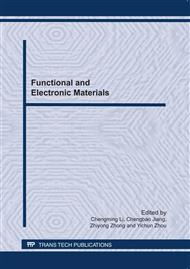p.247
p.251
p.257
p.263
p.269
p.275
p.279
p.283
p.287
Effect of Nb2O5 Addition on the Electrical and Physical Properties of Lead-Free 0.98(Na0.5K0.5)NbO3-0.02(Na0.5Bi0.5)TiO3 Piezoelectric Ceramics
Abstract:
In this paper, the effects of Nb2O5 addition on the electrical and physical properties of 0.98(Na0.5K0.5)NbO3-0.02(Na0.5Bi0.5)TiO3 were investigated. The 0.98(Na0.5K0.5)NbO3-0.02(Na0.5 Bi0.5)TiO3 [0.98NKN-0.02NBT] ceramics with the addition of 0~1.5 wt% Nb2O5 have been prepared following the conventional mixed oxide process. X-ray diffraction analysis revealed that, during sintering, all of the (Na0.5Bi0.5)TiO3 diffuse into the lattice of (Na0.5K0.5)NbO3 to form a solid solution, in which an orthorhombic phase with a perovskite structure was found. For 0.98NKN-0.02NBT ceramics by doping 0.3 wt% Nb2O5, the poled dielectric constant (K33T) is 1180. The electromechanical coupling coefficients of the planar mode kp and the thickness mode kt reach 0.43 and 0.52, respectively. Our results show that 0.98NKN-0.02NBT with the addition of 0.3 wt% Nb2O5 is a good lead-free piezoelectric ceramic.
Info:
Periodical:
Pages:
269-274
Citation:
Online since:
June 2011
Authors:
Keywords:
Price:
Сopyright:
© 2011 Trans Tech Publications Ltd. All Rights Reserved
Share:
Citation:


